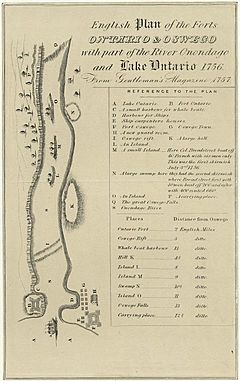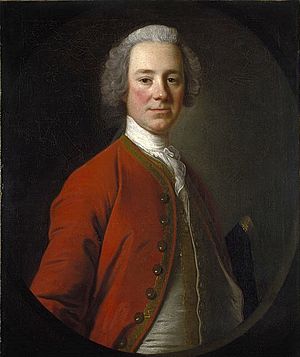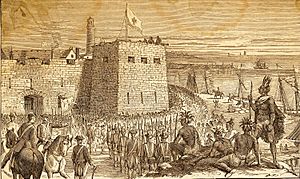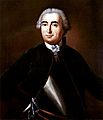Battle of Fort Oswego facts for kids
Quick facts for kids Battle of Fort Oswego |
|||||||
|---|---|---|---|---|---|---|---|
| Part of the French and Indian War | |||||||
 |
|||||||
|
|||||||
| Belligerents | |||||||
| Commanders and leaders | |||||||
| Louis-Joseph de Montcalm | James Mercer † John Littlehales |
||||||
| Strength | |||||||
| 3,000 French army, troupes de la marine, colonial militia, and Indians | 1,100 British army | ||||||
| Casualties and losses | |||||||
| 30 dead or wounded | 80–150 1,700 captured (including noncombatants) |
||||||
The Battle of Fort Oswego was an important event during the French and Indian War in North America. This war was part of a bigger worldwide conflict called the Seven Years' War. In August 1756, a French army led by General Montcalm attacked and captured the British forts at Fort Oswego. Today, this area is known as Oswego, New York.
The French victory was a big deal. They took 1,700 prisoners and 121 cannons. This win removed the British from Lake Ontario, which was a key waterway. It also showed that old-style European siege tactics could work well in North America.
Contents
Why the Battle Happened
The French and Indian War began in 1754. Both France and Britain sent soldiers to North America. They wanted to control lands like the Ohio Country and the border between French Canada and British province of New York. This area is now Upstate New York and was home to the Iroquois nations.
In 1755, the British planned to capture Fort Niagara on Lake Ontario. William Shirley, the governor of Province of Massachusetts Bay, made Fort Oswego stronger. He also built two new forts nearby: Fort George and Fort Ontario. But the plan to attack Fort Niagara didn't happen. The Oswego forts were guarded through the winter.
The French had the only large ships on Lake Ontario in 1755. They could move freely between Fort Niagara and Fort Frontenac. In March 1756, they attacked Fort Bull, which was a supply stop for the Oswego forts. They destroyed many supplies, ruining the British plan for 1756. French and Native American groups also started bothering the Oswego soldiers.
General Louis-Joseph de Montcalm arrived in Montreal in May 1756 to lead the French army. He and Governor Vaudreuil decided to attack Oswego.
Meanwhile, the British governor, William Shirley, was replaced. His replacement, General Loudoun, arrived in late July. Shirley had been trying to get supplies to Oswego. He also got support from the Iroquois and other Native American groups. John Bradstreet and his "battoemen" (boatmen) successfully brought supplies to Oswego in July. But they were attacked on their way back. When Loudoun arrived, he stopped Shirley's plans for an Oswego attack.
Oswego's Forts
The British had three forts at Oswego.
- Fort Ontario was on the east side of the Oswego River. It was a log fort built in 1755. About 370 soldiers from Pepperrell's Regiment guarded it.
- Fort Oswego was on the west side. It had stone and clay walls but was open to attack from Fort Ontario.
- Fort George was a new, unfinished wooden fort. It had only 150 New Jersey soldiers.
These last two forts didn't offer much protection. The soldiers had few cannons. Many soldiers had been there all winter and were sick from lack of food. Out of nearly 2,000 men, less than 1,200 were healthy enough to fight.
French Attack Plan
General Montcalm left Fort Carillon on July 16. He went to Montreal, then to Fort Frontenac. French soldiers and about 250 Native American warriors gathered there. The French force had about 3,000 men in total.
An advance group of 700 men went ahead. The main force left on August 4. They crossed Lake Ontario at night, landing east of Fort Ontario on August 10. The British didn't know they were there until a small boat saw them the next morning.
The Battle Begins
Montcalm's engineer went to check the British forts. He was accidentally shot and killed by one of the Native American allies. Pierre Pouchot took over the job of planning the attack.
On the night of August 11–12, the French started digging trenches. These trenches moved closer to Fort Ontario. The soldiers in Fort Ontario fired cannons and guns at the French. But late on August 13, the British soldiers left Fort Ontario. They did this even before the French trenches reached the fort.
Montcalm quickly took over Fort Ontario. He immediately started building cannon positions on the high ground. From here, they could fire directly at Fort Oswego's weak side. By the morning of August 14, the French had nine cannons ready. When they fired, Fort Oswego's stone walls began to crumble.
The British cannons in Fort Oswego were pointed away from the river. They weren't expecting an attack from that direction. They quickly turned their guns around and fired back. But Montcalm had sent some men across the river upstream. These men appeared near Fort Oswego at the same time that Colonel Mercer, the British commander, was killed by a French cannonball.
After Mercer's death, Lieutenant Colonel John Littlehales took command. He quickly decided to surrender and raised a white flag.
What Happened Next

The British surrendered about 1,700 people. This included soldiers, workers, women, and children. Montcalm didn't give the British the usual "honours of war" because he felt they didn't fight hard enough.
When the fort was opened, some French Canadian soldiers and Native Americans rushed in. They started taking things. Some British tried to escape and were killed. Montcalm was upset by this. He managed to stop more killings, but it cost him a lot of money in gifts to calm everyone down. He then ordered everything the French didn't need to be destroyed. After that, everyone, including the prisoners, went to Montreal.
On August 12, British reinforcements were sent towards Oswego. But when they heard Oswego had fallen, they turned back. General Loudoun later tried to blame William Shirley for the loss of Oswego. Shirley was cleared of charges, but some problems were found. Shirley later got other important jobs.
Oswego was left empty until 1758. Then, the British came back. They used it as a starting point for attacks on other French forts.
Images for kids
-
General Louis-Joseph de Montcalm led the French forces.
See also
 In Spanish: Batalla de Fort Oswego para niños
In Spanish: Batalla de Fort Oswego para niños



